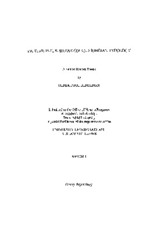| dc.creator | Benson, Derek Paul | |
| dc.date.accessioned | 2013-02-22T20:41:01Z | |
| dc.date.available | 2013-02-22T20:41:01Z | |
| dc.date.created | 2001 | |
| dc.date.issued | 2013-02-22 | |
| dc.identifier.uri | https://hdl.handle.net/1969.1/ETD-TAMU-2001-Fellows-Thesis-B46 | |
| dc.description | Due to the character of the original source materials and the nature of batch digitization, quality control issues may be present in this document. Please report any quality issues you encounter to digital@library.tamu.edu, referencing the URI of the item. | en |
| dc.description | Includes bibliographical references (leaf 19). | en |
| dc.description.abstract | This study examines a Jungian picture interpretation schema, which can be used to analyze artistic creations in a therapeutic format. This proposed schema attaches significance to specific areas of a drawing. The upper left of a drawing is associated with the father; the lower left with the unconscious; the lower right with mother; and the upper right with the future. Although this Jungian quadrant schema is intriguing, and seeing it put to practice makes it appear valid, it leads an inquisitive mind to wonder many things. Three questions will serve as the foci of this study. First I will address the question of the Jungian schema's validity. I will attempt to find whether a positive association is present between particular quadrants of a drawing and the proposed meanings suggested by this schema. The second question is whether certain personality types within Jung's typology will respond better than others to the schema. Specifically, it is hypothesized that individuals with an introverted, intuitive, feeling typology will perform better than those with other typologies. The third question I will address is whether the schema works best when it elicits a strong affective response from the person who created the picture. It is the hypothesis of this study that individuals with high levels of emotional arousal in response to a picture will tend to perform better than those with little or no emotional response in validating the proposed schema. Two hundred and seven introductory psychology students participated in the study. There were two tests a subject could take: a space domain test, or a color associative test. In both tests, subjects took the Personal Preferences Self Description Questionnaire (PPSDQ), made drawings, and filled out the Self Assessment Manikin, a measure of affective response. Means analyses and t-tests were performed. Analysis revealed only two significant effects: a positive correlation with the unconscious quadrant and a negative correlation with the mother quadrant. The remaining analyses revealed no significant effects. These results suggest that this Jungian schema used to interpret drawings may be invalid and of little practical utility. | en |
| dc.format.medium | electronic | en |
| dc.format.mimetype | application/pdf | |
| dc.language.iso | en_US | |
| dc.publisher | Texas A&M University | |
| dc.rights | This thesis was part of a retrospective digitization project authorized by the Texas A&M University Libraries in 2008. Copyright remains vested with the author(s). It is the user's responsibility to secure permission from the copyright holder(s) for re-use of the work beyond the provision of Fair Use. | en |
| dc.subject | psychology. | en |
| dc.subject | Major psychology. | en |
| dc.title | Picture interpretation and Jungian typology | en |
| thesis.degree.department | psychology | en |
| thesis.degree.discipline | psychology | en |
| thesis.degree.name | Fellows Thesis | en |
| thesis.degree.level | Undergraduate | en |
| dc.type.genre | thesis | en |
| dc.type.material | text | en |
| dc.format.digitalOrigin | reformatted digital | en |


